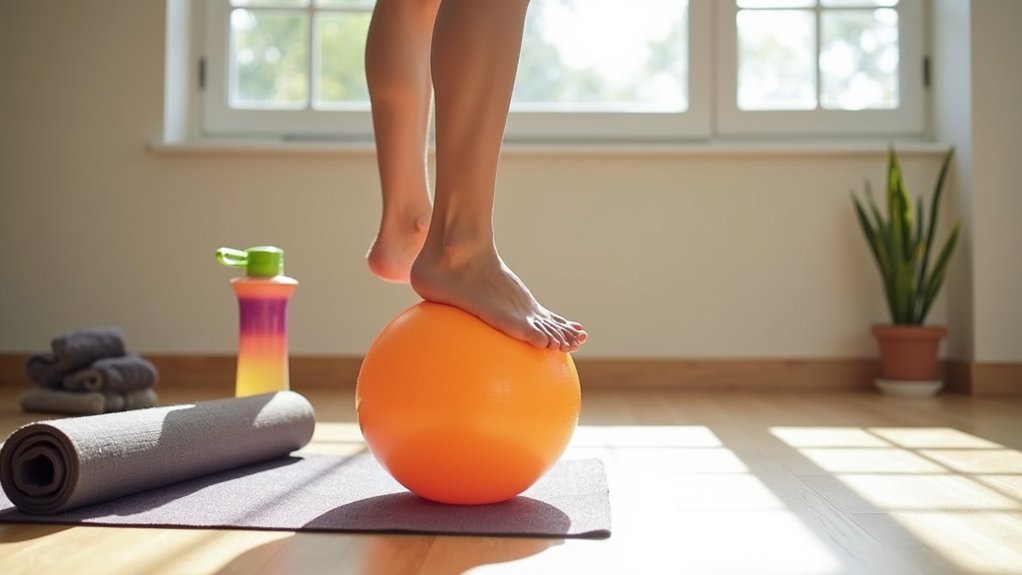For quick muscle recovery, try these mini-exercises: 1) Basic Gentle Bounce – stand on a rebounder with slightly bent knees and bounce gently for 5-10 minutes to enhance circulation; 2) Alternating Knee Lifts – perform immediately post-workout for 2-3 minutes to flush out lactic acid; 3) Seated Bounce – do five minutes of seated bouncing to improve lower body recovery with 87% less impact shock. These techniques supercharge your lymphatic system and accelerate healing in less time than traditional methods.
Why Rebounding Is Perfect for Muscle Recovery

Five powerful ways rebounding transforms muscle recovery: it supercharges blood circulation, delivering oxygen and nutrients directly to damaged tissues while efficiently clearing lactic acid buildup.
This gentle bouncing motion reduces post-workout soreness and accelerates repair of muscle microtears.
Unlike high-impact exercises, rebounding strengthens without strain. NASA research found that 10 minutes of rebounding equals 30 minutes of running for cardiovascular benefits, making it an incredibly efficient recovery method. Just 10-15 minutes can dramatically decrease muscle stiffness and minimize delayed-onset soreness you’d typically feel the next day.
The rhythmic up-and-down motion creates ideal conditions for healing—NASA research suggests it’s more time-efficient than running for cardiovascular benefits while protecting your joints.
For athletes, it’s an excellent active recovery tool that maintains fitness without compromising healing. Your body gets the perfect balance of stimulation and protection.
The Science Behind Rebounding and Lymphatic Drainage
Rebounding creates a pump-like effect on your lymphatic system, which lacks its own pump mechanism and relies on physical movement to circulate fluids.
When you bounce on a rebounder, the gravitational changes accelerate lymph flow up to 15 times normal rates, helping flush metabolic waste from your muscles more efficiently.
This enhanced lymphatic drainage removes cellular debris and inflammatory compounds that accumulate during intense exercise, allowing for faster recovery and reduced muscle soreness. The process uses gentle pressure techniques similar to those applied in lymphatic drainage massage, enhancing the body’s natural waste removal systems.
Lymph Flow Enhancement
While often overlooked in traditional recovery programs, your lymphatic system plays an essential role in muscle repair and overall wellness. Unlike your circulatory system, lymph fluid moves exclusively through muscular contractions and breathing—it has no dedicated pump.
To maximize recovery, incorporate gentle rebounding exercises on a mini-trampoline. The vertical motion creates beneficial gravitational shifts that stimulate lymphatic vessels while remaining low-impact. Even 5-10 minutes of bouncing can increase lymph flow 3-6 times above resting levels. This technique helps prevent lymphatic stagnation, which can otherwise lead to swelling, fatigue, and compromised immune function.
Combine rebounding with deep, diaphragmatic breathing to enhance thoracic duct pumping. For targeted relief, add muscle-tightening exercises with 4-6 second isometric holds, especially effective for post-workout swelling or reducing adhesions after injury.
Daily consistency matters since lymph drainage requires regular movement.
Cellular Waste Removal
Beneath the surface-level benefits of rebounding exercises lies a fascinating cellular process that powers your muscle recovery. When you jump on a mini-trampoline, you’re activating proteins like BAG3 that form cellular “garbage bags” called autophagosomes, which encapsulate and remove damaged components from your muscles. The findings from research conducted by an international research team at the University of Bonn highlight this critical mechanism for clearing cellular waste.
| Rebounding Effect | Cellular Response | Recovery Benefit |
|---|---|---|
| Gentle compression | BAG3 activation | Prevents muscle weakness |
| Rhythmic movement | Autophagosome formation | Reduces inflammation |
| Gravity variation | Waste encapsulation | Enhances tissue repair |
| Lymphatic stimulation | Metabolic cleanup | Speeds recovery time |
| Consistent bouncing | Cellular recycling | Supports muscle longevity |
Without this essential waste removal system, your muscles would accumulate damage, potentially leading to weakness and even heart issues. Just 5-10 minutes of rebounding can jumpstart these cellular cleaning mechanisms.
Basic Gentle Bounce for Post-Workout Relief

Start with a gentle, controlled bounce by standing on your mini-trampoline and bending your knees slightly while maintaining minimal height.
This basic technique stimulates your lymphatic system and increases blood circulation, delivering oxygen and nutrients to your recovering muscles.
You’ll notice improved cardiovascular efficiency as the bouncing motion reduces blood pooling in your veins and enhances overall circulation throughout your body. This gentle rebounding exercise is low-impact exercise suitable for individuals of all ages, making it ideal for recovery days.
Basic Gentle Bounce Technique
The Basic Gentle Bounce Technique offers a soothing yet effective approach to muscle recovery after intense workouts. This low-impact exercise stimulates your lymphatic system, helping to flush out toxins while gently engaging your muscles without strain.
To incorporate this technique effectively:
- Stand with slightly bent knees on a rebounder or mini-trampoline, keeping your posture upright.
- Bounce gently without your feet leaving the surface—just enough to feel a slight lift.
- Continue for 5-10 minutes, focusing on controlled, rhythmic movements.
- Combine with deep breathing to enhance circulation and relaxation benefits.
This gentle bouncing serves as a form of active recovery that promotes blood flow to healing tissues while minimizing stress on sore muscles.
You’ll find this method particularly valuable on recovery days when your body needs activity without stress.
Remember to stay hydrated and listen to your body—stop immediately if you experience any discomfort.
Benefits for Circulation
When your muscles have worked hard during intense exercise, your circulatory system needs gentle stimulation to kickstart the recovery process effectively.
The gentle bounce technique creates a pumping action that flushes metabolic waste products like lactate and hydrogen ions from your muscles.
This rhythmic movement enhances blood flow, delivering oxygen and nutrients to repair damaged muscle fibers while simultaneously supporting your lymphatic system in removing cellular debris.
You’ll experience reduced muscle stiffness as improved circulation promotes synovial fluid movement in your joints.
The gentle mechanical stress maintains vascular elasticity, which not only speeds your current recovery but also improves future workout efficiency.
This circulation boost prevents venous pooling in your extremities and helps stabilize blood pressure through improved baroreceptor sensitivity during these critical post-exercise moments.
Unlike static recovery methods, this gentle bounce technique is a form of active recovery that helps promote healing without causing additional stress to already fatigued muscles.
Alternating Knee Lifts to Flush Out Lactic Acid
After intense workouts leave your muscles sore and fatigued, alternating knee lifts can provide a simple yet effective solution for recovery.
This low-intensity exercise increases blood flow, which helps redistribute and remove lactic acid buildup in your leg muscles.
Unlike passive recovery methods, these active movements accelerate the healing process.
Active recovery isn’t just an option—it’s a catalyst that speeds up muscle healing when your body needs it most.
You’ll find knee lifts particularly beneficial because they’re accessible to all fitness levels and can be performed seated or lying down.
Modern research has debunked the old idea that lactic acid must be “drained,” as it’s actually a fuel source that your body naturally utilizes for energy.
For maximum benefit:
- Perform knee lifts immediately post-workout for 2-3 minutes
- Combine with deep breathing to enhance circulation
- Maintain a controlled pace to optimize lactic acid removal
- Include them in regular recovery routines for consistent results
These simple movements outperform static stretching, making them an efficient addition to your recovery toolkit.
Seated Bounce Technique for Lower Body Recovery

Five minutes of seated bounce technique can revolutionize your lower body recovery process. This low-impact exercise primarily engages your calves while improving circulation through enhanced venous return. You’ll notice improved proprioception as the mini-trampoline’s uneven surface challenges your balance. This technique provides a 87% reduction in impact shock compared to exercising on hard surfaces.
| Benefit | Primary Muscles | Recovery Impact |
|---|---|---|
| Increased lymphatic flow | Calves & ankles | Reduces swelling |
| Improved circulation | Core & glutes | Flushes out toxins |
| Enhanced stability | Hip flexors | Prevents future injury |
Start with slow, rhythmic bounces and gradually increase intensity. For best results, lean forward or backward to target different muscle groups. Combine this technique with post-bounce stretching and proper hydration to maximize recovery. Your lower body will thank you as this simple exercise strengthens muscles while minimizing joint stress.
When to Incorporate Rebounding Into Your Recovery Routine
Understanding the ideal timing for rebounding can maximize its benefits for muscle recovery. Your body responds differently to this low-impact exercise depending on when you use it within your recovery cycle.
- Immediately post-workout (15-30 minutes after exercise): Spend 5-10 minutes doing gentle bounces to stimulate lymphatic drainage and shift into recovery mode, pairing with hydration for enhanced toxin removal. This approach activates the parasympathetic nervous system which is essential for effective recovery.
- During DOMS onset (24-72 hours post-exercise): Perform 3-5 minute intervals every few hours with stability-focused moves like heel taps, keeping your heart rate at 40-50% max.
- On low-intensity days: Replace rest-day inactivity with two 10-minute gentle rebounding sessions, focusing on controlled movements.
- During multi-day recovery blocks: Schedule 20-minute sessions alternating with foam rolling to accelerate lactate clearance.
How Mini-Trampoline Exercises Reduce DOMS
Mini-trampoline exercises reduce muscle soreness by providing a low-impact way to boost lymphatic circulation, which helps clear inflammatory byproducts.
The gentle bouncing motion stimulates fluid movement through your tissues without aggravating already tender muscles. Studies show mini-trampoline workouts provide light to moderate intensity exercise that’s gentle enough for recovery days.
You’ll experience less inflammation as your body more efficiently removes metabolic waste that contributes to delayed onset muscle soreness.
Rebounding Lessens Inflammation
Bounce away your post-workout pain on a mini-trampoline to greatly reduce muscle inflammation and soreness.
The rhythmic bouncing action stimulates your lymphatic system, which doesn’t have its own pump like your circulatory system does. This enhanced lymphatic flow helps flush inflammatory byproducts and metabolic waste from your tissues faster.
The inflammation-fighting benefits of rebounding include:
- Accelerated lactic acid removal through improved lymphatic drainage
- Reduced inflammatory cytokines that typically prolong DOMS duration
- Decreased cortisol levels through gentle, low-stress movement patterns
- Enhanced oxygen delivery to healing tissues via improved circulation
Your muscles recover more efficiently when you incorporate mini-trampoline work between intense training sessions, creating a natural anti-inflammatory response without medication. Even short 10- to 15-minute sessions after training can significantly improve muscle recovery and reduce next-day soreness.
Low-Impact Lymphatic Boost
When your muscles scream the day after intense exercise, a mini-trampoline offers the perfect solution through its unique low-impact lymphatic boost. The gentle bouncing creates vertical G-forces that open and close lymphatic valves, effectively flushing out metabolic waste that causes soreness. This gentle impact simultaneously strengthens bones while promoting recovery.
Unlike high-impact activities, rebounding absorbs 80% of landing force while still creating enough pressure changes to stimulate lymph flow. Just 10-15 minutes of gentle “health bounces” can greatly reduce DOMS without stressing your joints.
| Rebounding Benefit | How It Works | Recovery Impact |
|---|---|---|
| Lymphatic Drainage | Creates 0.5-1.5G forces | Flushes metabolic waste |
| Joint Protection | Absorbs 80% of impact | Allows recovery without rest |
| Full-Body Activation | Engages multiple muscle groups | Improves circulation system-wide |
Optimal Duration of Rebounding Recovery Sessions
Finding the right duration for your rebounding sessions is essential to maximize recovery benefits while preventing fatigue. Most recovery-focused sessions should last between 10-15 minutes, offering ample time for lymphatic stimulation and muscle relaxation without overexertion.
For ideal recovery results, consider these duration guidelines:
- Beginners: Start with 5-10 minute sessions, gradually increasing as your body adapts.
- Recovery focus: 10-15 minutes is ideal for lymphatic drainage and muscle tension release. According to research, this targeted duration provides low-impact exercise benefits while allowing muscles to recover properly.
- Split sessions: Two 10-minute sessions (morning and evening) can be more effective than one longer session.
- Health considerations: If you’re older or have medical conditions, begin with just 2-5 minutes and progress slowly.
Adjust your rebounding time based on how your body responds, tracking improvements in soreness and recovery rates.
Combining Rebounding With Other Recovery Methods
While rebounding alone offers significant recovery benefits, combining it with complementary methods creates a powerful synergistic effect that accelerates muscle healing.
Try wearing compression garments during your rebounding sessions to improve venous return and reduce muscle vibration. After bouncing, consider cold therapy applications—ice packs on overworked muscles limit inflammation without hindering the lymphatic drainage you’ve stimulated.
Time your nutrition strategically: consume protein within 30 minutes post-rebounding when circulation is heightened, optimizing muscle repair. The low-impact aerobic nature of rebounding exercises makes it ideal for recovery days when joints need protection while still maintaining circulation. Hydrate with electrolyte-rich fluids to flush out metabolic waste more efficiently.
For maximum flexibility gains, perform dynamic stretches immediately after rebounding when your tissues are warm and pliable. Tech-savvy athletes can use wearable muscle sensors to track recovery metrics and adjust their protocols accordingly.
Rebounding vs. Traditional Active Recovery Techniques
As fitness enthusiasts increasingly explore diverse recovery methods, comparing rebounding with traditional active recovery reveals distinct advantages for each approach. The mini-trampoline offers unique benefits through low-impact, dynamic movements that traditional methods may not provide.
- Mechanical Difference: Rebounding engages multiple muscle groups through plyometric movements, while traditional recovery uses steady-state activities like walking or cycling. Both approaches prioritize blood flow to facilitate nutrient delivery and waste removal during the recovery process.
- Joint Impact: Mini-trampoline work considerably reduces joint stress while maintaining bone-loading benefits compared to ground-based exercises.
- Equipment Requirements: You’ll need a rebounder for this approach, whereas traditional methods often require minimal gear like foam rollers.
- Recovery Focus: Rebounding excels for neuromuscular rehabilitation and balance improvement, while traditional techniques directly target inflammation reduction and soreness.
Equipment Guide: Choosing the Right Rebounder for Recovery
Selecting the right rebounder stands as one of the most essential decisions for optimizing your muscle recovery routine. Focus on durability and bounce mechanism—bungee cord models offer quieter, safer workouts than spring versions.
For home use, consider foldable options that save space without sacrificing stability. Your recovery needs should dictate features. If balance is a concern, look for models with adjustable support handles. The weight capacity rating ensures your rebounder will maintain its performance and durability throughout your recovery journey.
Therapeutic rebounders work best for injury recovery with their gentler bounce, while commercial-grade options serve intense training regimens. Don’t overlook weight capacity and safety features like protective covers.
The ideal rebounder matches your available space, budget constraints, and specific recovery goals while requiring minimal maintenance—ensuring your investment supports long-term healing.
Adapting Rebounding Intensity to Your Fitness Level
Customizing your rebounding intensity based on fitness level guarantees ideal muscle recovery without overtraining. Your heart rate zones determine best recovery benefits – beginners should aim for 50-60% of maximum heart rate with simple static marches, while intermediate bouncers can work at 60-70% with lateral movements.
Rebounding at appropriate heart rate zones maximizes recovery while preventing the strain of excessive intensity.
Consider these intensity adjustments based on your recovery needs:
- Duration progression – Start with 15-20 minutes as a novice and gradually build to 30-45 minutes as your fitness improves.
- Movement complexity – Begin with static bouncing before adding directional changes or arm movements.
- Interval structure – Alternate 60-second periods between mid and high-blue heart rate zones.
- Recovery monitoring – Track sleep quality and HRV scores to validate your intensity choices and adjust accordingly.
Properly designed recovery workouts should keep your heart rate above 100 bpm while staying in the blue zone for optimal recovery intensity without adding unnecessary stress to your system.
Tracking Progress: Measuring Recovery Improvements With Rebounding
Tracking your recovery progress while using a rebounder provides concrete evidence of your body’s adaptations and helps fine-tune your routine for ideal results.
Monitor your muscular strength through 1-RM tests and observe how quickly your blood lactate levels normalize after workouts.
You’ll notice improvements in countermovement jump performance—a key indicator that typically recovers within six hours in non-fatigued states.
Track your DOMS levels; decreased soreness signals enhanced blood flow and lymphatic drainage from rebounding. The rebounding motion creates a unique pump effect that significantly improves lymphatic system function. For objective measurement, consider using pain inventories or force plates to assess vertical jump power.
Compare your recovery time with other modalities like foam rolling or passive rest.
You’ll likely find rebounding offers superior results for lymphatic activation while delivering aerobic benefits comparable to cycling—without the joint stress.
Frequently Asked Questions
Can Rebounding Worsen Joint Pain in Injured Athletes?
While rebounding is generally low-impact, it can worsen joint pain if you use improper technique or excessive intensity. However, when done correctly, it’s actually protective for your joints during injury recovery.
Are There Age Restrictions for Rebounding Recovery Techniques?
No formal age restrictions exist for rebounding, but you’ll need adaptations for different groups. Children need supervision, seniors might require stability bars, and anyone with medical conditions should consult their doctor first.
How Does Rebounding Affect Blood Pressure During Recovery?
Rebounding lowers your blood pressure during recovery by enhancing circulation through rhythmic contractions. You’ll experience improved oxygen flow, strengthened heart muscles, and reduced systolic and diastolic values as your cardiovascular system stabilizes.
Can Rebounding Replace Post-Workout Protein Intake?
No, rebounding can’t replace post-workout protein intake. While it helps circulation and reduces soreness, you still need protein for muscle repair and synthesis. They’re complementary, not interchangeable, in your recovery strategy.
Is Rebounding Effective for Recovery After Endurance Sports?
Rebounding shows promise for endurance recovery through improved circulation and lymphatic drainage, but research specifically for endurance athletes is limited. You’ll likely benefit from it as a low-impact active recovery option alongside your regular recovery routine.
In Summary
Add rebounding to your recovery routine and you’ll experience faster muscle rejuvenation with minimal effort. Just 5-10 minutes of gentle bouncing after workouts helps flush lactic acid, stimulates lymphatic drainage, and reduces soreness. Start with the three exercises above, adjust intensity to your fitness level, and track how your recovery times improve. Your muscles will thank you for this low-impact, high-reward addition.





Leave a Reply